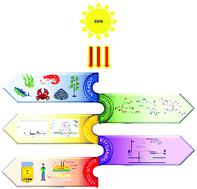当前位置:
X-MOL 学术
›
Mater. Chem. Front.
›
论文详情
Our official English website, www.x-mol.net, welcomes your feedback! (Note: you will need to create a separate account there.)
A roadmap to UV-protective natural resources: classification, characteristics, and applications
Materials Chemistry Frontiers ( IF 7 ) Pub Date : 2021-08-18 , DOI: 10.1039/d1qm00741f Santhra Krishnan P 1 , Ashritha Salian 1 , Saikat Dutta 2 , Saumen Mandal 1
Materials Chemistry Frontiers ( IF 7 ) Pub Date : 2021-08-18 , DOI: 10.1039/d1qm00741f Santhra Krishnan P 1 , Ashritha Salian 1 , Saikat Dutta 2 , Saumen Mandal 1
Affiliation

|
Alongside the innumerable benefits of solar rays, the adverse effects of ultraviolet (UV) radiation must be considered. All organisms are subjected to the deleterious effects of UV radiation, particularly UVA (315–400 nm) and UVB (280–315 nm). Continuous UV exposure leads to skin cancer, erythema, and sunburn mediated by reactive oxygen species (ROS). Photoprotection is hence an indispensable feature in all strata of the ecosystem across the microbial, plant, and animal kingdoms, especially under the present circumstance of increased ozone depletion. Photoprotective compounds, like gadusols, mycosporine-like amino acids (MAAs), scytonemin, phenolic compounds like flavonoids, anthocyanins, lignin, and less-explored compounds like sporopollenin, parietin, and usnic acid have been identified in various organisms. Accumulation of photoprotective pigments is a universal mechanism of passive protection against UV, developed by organisms during the early stages of their evolution. Furthermore, many of these compounds contribute to antioxidant and anti-inflammatory actions, which offer additional protection. In this review, the attributes of naturally available UV-screening compounds are investigated. Their taxonomic diversity, mechanism of UV absorption, extraction, and characterization techniques are discussed. In the wake of recent studies that indicate free radical generation in inorganic sunscreen compounds like TiO2 and ZnO, natural products have become a necessity. Insights into natural compounds for photoprotective functions in commercial applications like cosmetics and textiles are also reviewed. Biocompatibility and minimal side effects of these natural compounds open the gateway into an era of green products in the arena of photoprotection.
中文翻译:

紫外线防护自然资源路线图:分类、特征和应用
除了太阳光线的无数好处外,还必须考虑紫外线 (UV) 辐射的不利影响。所有生物体都会受到紫外线辐射的有害影响,尤其是 UVA (315-400 nm) 和 UVB (280-315 nm)。持续的紫外线照射会导致皮肤癌、红斑和由活性氧 (ROS) 介导的晒伤。因此,光保护是微生物、植物和动物界生态系统所有层次中不可或缺的特征,尤其是在目前臭氧消耗增加的情况下。光保护化合物,如 gadusols、类菌孢素氨基酸 (MAA)、scytonemin、酚类化合物如类黄酮、花青素、木质素,以及较少探索的化合物如孢粉素、parietin 和松萝酸等已在各种生物体中被鉴定出来。光保护色素的积累是一种普遍的被动防护紫外线机制,由生物体在进化的早期阶段发展而来。此外,许多这些化合物有助于抗氧化和抗炎作用,从而提供额外的保护。在这篇综述中,研究了天然可用的紫外线屏蔽化合物的属性。讨论了它们的分类多样性、紫外吸收机制、提取和表征技术。最近的研究表明无机防晒化合物(如二氧化钛)中会产生自由基 提供额外的保护。在这篇综述中,研究了天然可用的紫外线屏蔽化合物的属性。讨论了它们的分类多样性、紫外吸收机制、提取和表征技术。最近的研究表明无机防晒化合物(如二氧化钛)中会产生自由基 提供额外的保护。在这篇综述中,研究了天然可用的紫外线屏蔽化合物的属性。讨论了它们的分类多样性、紫外吸收机制、提取和表征技术。最近的研究表明无机防晒化合物(如二氧化钛)中会产生自由基2和ZnO,天然产物已成为必需品。还审查了对在化妆品和纺织品等商业应用中具有光保护功能的天然化合物的见解。这些天然化合物的生物相容性和最小的副作用打开了进入光保护领域绿色产品时代的大门。
更新日期:2021-09-08
中文翻译:

紫外线防护自然资源路线图:分类、特征和应用
除了太阳光线的无数好处外,还必须考虑紫外线 (UV) 辐射的不利影响。所有生物体都会受到紫外线辐射的有害影响,尤其是 UVA (315-400 nm) 和 UVB (280-315 nm)。持续的紫外线照射会导致皮肤癌、红斑和由活性氧 (ROS) 介导的晒伤。因此,光保护是微生物、植物和动物界生态系统所有层次中不可或缺的特征,尤其是在目前臭氧消耗增加的情况下。光保护化合物,如 gadusols、类菌孢素氨基酸 (MAA)、scytonemin、酚类化合物如类黄酮、花青素、木质素,以及较少探索的化合物如孢粉素、parietin 和松萝酸等已在各种生物体中被鉴定出来。光保护色素的积累是一种普遍的被动防护紫外线机制,由生物体在进化的早期阶段发展而来。此外,许多这些化合物有助于抗氧化和抗炎作用,从而提供额外的保护。在这篇综述中,研究了天然可用的紫外线屏蔽化合物的属性。讨论了它们的分类多样性、紫外吸收机制、提取和表征技术。最近的研究表明无机防晒化合物(如二氧化钛)中会产生自由基 提供额外的保护。在这篇综述中,研究了天然可用的紫外线屏蔽化合物的属性。讨论了它们的分类多样性、紫外吸收机制、提取和表征技术。最近的研究表明无机防晒化合物(如二氧化钛)中会产生自由基 提供额外的保护。在这篇综述中,研究了天然可用的紫外线屏蔽化合物的属性。讨论了它们的分类多样性、紫外吸收机制、提取和表征技术。最近的研究表明无机防晒化合物(如二氧化钛)中会产生自由基2和ZnO,天然产物已成为必需品。还审查了对在化妆品和纺织品等商业应用中具有光保护功能的天然化合物的见解。这些天然化合物的生物相容性和最小的副作用打开了进入光保护领域绿色产品时代的大门。



























 京公网安备 11010802027423号
京公网安备 11010802027423号